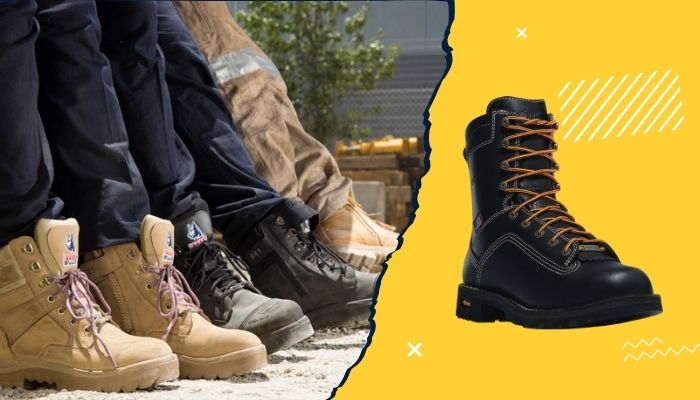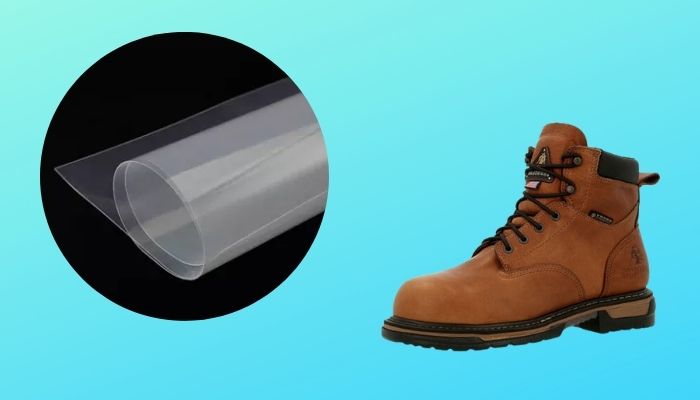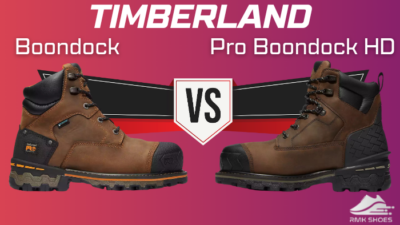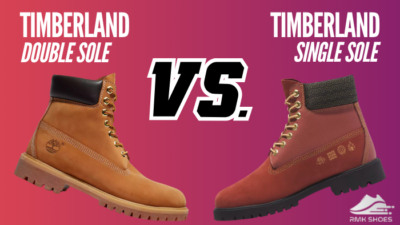So, you want to know if non-metallic and steel toes are the same thing?
Don’t worry. You will get to know me in this informative article.
After thorough research on non-metallic toe and steel toe, I am here to explain to you all the differences and similarities between the two.

Without wasting further time, let’s hop straight into the writing to know everything in detail.
Is Non-Metallic Toe The Same As Steel Toe?
No, the non-metallic toe, also called the composite toe, is not the same as the steel toe. The non-metallic composite toe, as the name implies, does not contain any metal, but the steel toe does. Because the non-metallic and steel toes are constructed of different materials, they behave differently.
The only thing that non-metallic and steel toes have in common is that they are both safety footwear that protects the feet. Aside from that, non-metallic and steel toes are significantly different from one another.
The most notable difference between composite and steel toe is the toe material.
The steel toe is made of metal, whereas the composite toe is built of non-metal components.
Metal and non-metal are two different materials with unique chemical properties; hence they cannot be the same.
But both the toes are the best with their unique features.
Check out my new post on Are Steel-Toe Boots Heavy.
What Is Non-Metallic Toe Made Of?
Non-metallic toe is nothing but a composite toe. Composite toes are called non-metallic because their toe cap is not made from metal.
Because of its non-metallic nature, the composite toe is one of the most preferred toes for use in hazardous environments.
Non-metallic materials like Kevlar, plastic, fiberglass, and carbon fiber are used to make composite toes.
These materials are also incredibly light and breathable. As a result, your feet will not feel tired, and you will be able to wear the boots for a longer period of time.
Because Kevlar, plastic, fiberglass, and carbon fiber are good insulators, the composite toe is an excellent choice for winter. Since there is no metal to conduct cold, thus the feet remain toasty in cold weather.

Additionally, the composite toes cannot conduct heat, so your feet won’t get too hot in the scorching summer.
Composite toe boxes are wider, unlike other metallic toes, letting your toes move easily.
But before that, go through our epic guide on How Much Do Steel Toe Work Boots Weigh.
What Is Steel Toe Made Of?
Steel toe is made from steel, reinforced with thermoplastic polyurethane (TPU) or aluminum.
Steel is made up of carbon which is a non-metal, and iron which is a metal. So, steel toe is not purely metal, but they do have traces of metal which let them function as metallic materials.
Steel toe boots are the number one choice for people who work on construction sites, as they keep the toes protected from falling heavy and sharp objects.
Because steel toes are heavy, they keep your feet safe even if you drop anything heavy on your toes.
Steel toes with steel plates also provide puncture resistance. As a result, your feet will be safe even if the boots are hit by sharp objects.

Steel toes have a variety of benefits, but they also have some drawbacks. The boot’s steel toe rapidly transfers heat, making it too hot to wear.
In addition, the toe box is narrow, which causes the toes to crumple excessively.
Also read, Do Steel Toe Boots Make Your Feet Colder.
Main Differences Between Non-Metallic Toe And Steel Toe?
Non-metallic toe and steel toe are the best in their respective field. For construction workers who work in risky environments, non-metallic toe boots and steel toe boots are trusted names.
However, both toes have unique features which make them different from each other.
Here are the differences between non-metallic toes and steel toes:
| Non-Metallic Toe | Steel Toe |
|---|---|
| The toe cap is constructed of non-metallic materials such as plastics, fiberglass, carbon fiber, and Kevlar. | Steel, a metal, is used to make the toe cap. |
| It doesn't offer much foot protection. | Provides additional protection since they can endure more impact. |
| When passing through a metal detector, it does not set off an alarm. | When passing past a metal detector, it sets off an alarm. |
| Not so sturdy | Very sturdy and durable |
| Quite light due to the lack of metallic toe caps and weights between 1.75 lbs to 4 lbs. | Steel toes add weight to boots, weighing between 3.5 and 4.5 pounds. |
| Non-metallic toe boots are breathable, making them comfortable to wear for a long period of time. | Steel toe boots are quite rigid and not at all breathable, making them difficult to wear. |
You may like to read: Will Steel Toe Boots Set Off Metal Detectors.
Are Non-Metallic And Steel Toes OSHA Approved?
Non-metallic and steel toes are both permitted by OSHA. Non-metallic and steel toes are both safety footwear that meets all OSHA regulations. Both toes are OSHA authorized, so you can wear them in any hazardous environment and keep your feet safe.
OSHA does not approve normal shoes or sandals. To meet OSHA standards, the boots must be heavy-duty and meet certain other requirements.
OSHA requires slip-resistant and puncture-resistant safety boots. In addition, the safety boots must be sturdy enough to withstand severe impacts and protect the feet from falling heavy objects.
OSHA requires workers to wear special footwear to work for foot safety, and if the employer fails to provide OSHA-compliant footwear or the workers do not wear it, they must pay a fine.
Fortunately, non-metallic toe, also known as composite toe and steel toe, fits all of the criteria, such as being slip-resistant, puncture-resistant, electrically safe, and so on.
Check out to know Composite Toe Vs Steel Toe Boots.
Which Is Better Between Non-Metallic And Steel Toe?
If you do a battle round between non-metallic toe and steel toe there will be no clear winner. Because both the toes are made with different materials and both of them serve a different purpose.
For example, composite toes are lightweight and steel toes are heavy, but these weight differences in both the toes provide benefits to your feet. How?
The lightweight composite toe keeps the foot comfortable by not adding unnecessary bulk. On the other hand, the heavy steel toe ensures that the feet are protected during an impact.
Composite toe and steel toe are the best safety footwear that meets OSHA requirements. Both the toes perform well when put under test. Now, the rest is up to you, choose any of the toes that best suited your work.
Conclusion
The non-metallic toe and steel toe may not function similarly but their unique features surely make them the best in their own field.
The ultimate goal of non-metallic and steel toes is to protect your feet from accidents and impacts and they both do this perfectly.
Since both the toes are OSHA-approved, you are ensuring that they are puncture-resistant, slip-resistant, safe from electrical hazards, and many more.
However, make sure to choose high-quality safety boots that have received OSHA approval, as there are numerous low-cost composite toe and steel toe boots that give no foot protection.
That’s all for today. I hope you got all your answers through this article. If you have any other questions regarding this topic feel free to comment below.




